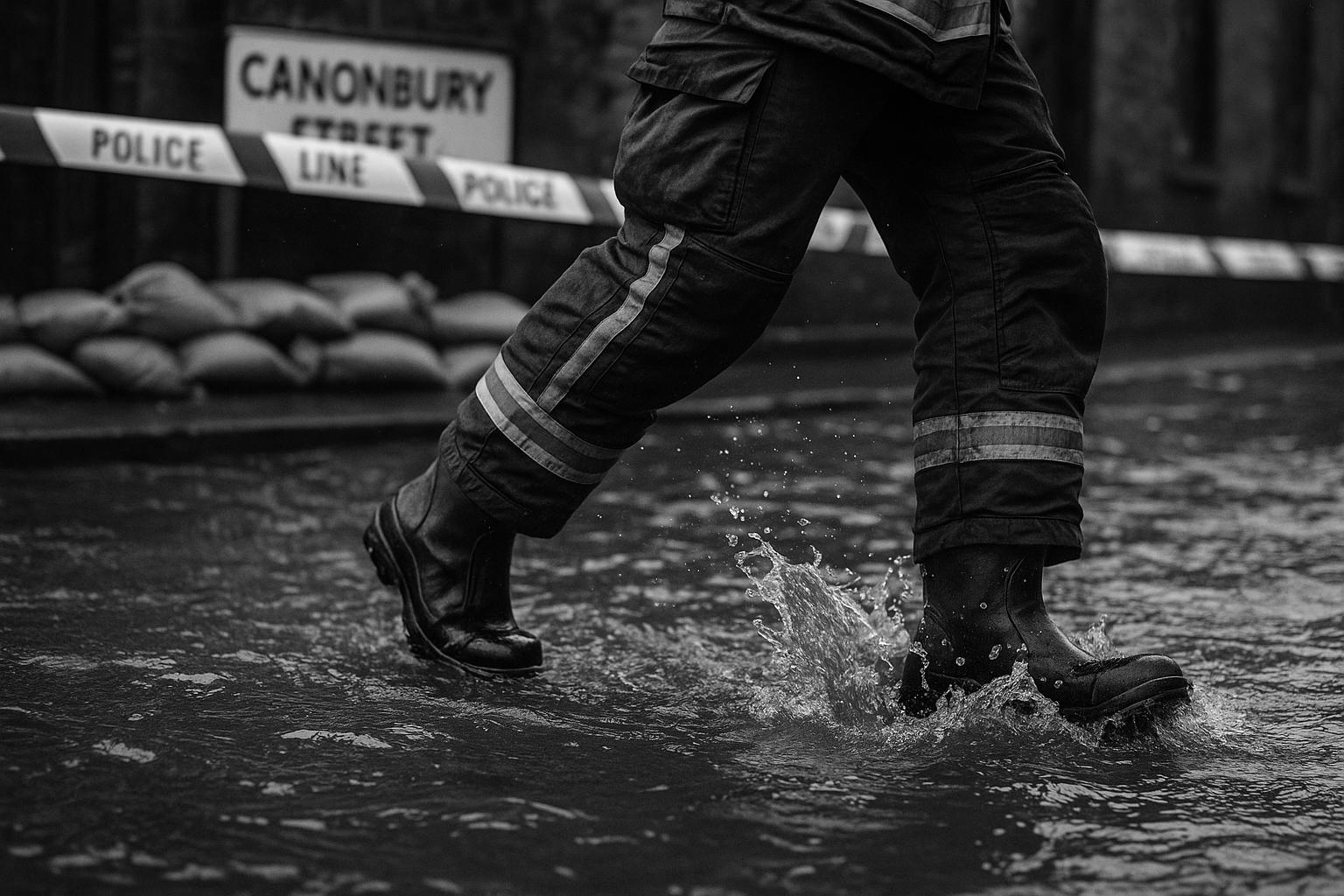A 36-inch trunk main failed late on Sunday, sending roughly 40cm of water into streets and basements around Canonbury Street and nearby roads. Around 30 people were evacuated as ten fire engines and about 70 firefighters joined Thames Water, Islington Council and the Metropolitan Police in a multi‑agency response to locate and repair the pipe and protect properties.
A major burst water main in Islington forced dozens of residents from their homes and left several streets under deep floodwater late on Sunday evening. Around 30 people were evacuated from properties on Canonbury Street, Essex Road, Elmore Street, Halliford Street and Ecclesbourne Road after emergency crews were called to a large-scale leak that sent water into basements and across road surfaces. According to the original report, the evacuation began as flooding spread through the residential streets.
A spokesperson for the London Fire Brigade said ten fire engines and “around 70 firefighters are dealing with flooding in the area around Canonbury Street in Islington.” The brigade described the cause as a 36‑inch burst water main and estimated flood depths of roughly 40 cm in places. Crews employed flood barriers and sandbags in an effort to protect properties and limit further water ingress.
Thames Water, Islington Council and the Metropolitan Police were all involved in the response. Thames Water confirmed engineers were on site to locate and repair the damaged pipe, while council teams and police helped manage the cordoned area and support evacuated residents. One broadcaster reported that Thames Water later located and repaired the damage, although recovery work and checks on affected properties continued.
Emergency control centres said they received a large number of calls after the failure was first noticed shortly before 10pm on Sunday, prompting neighbours and drivers to be warned to avoid the area. The fire service and police urged members of the public not to drive through flood water and to heed road closures and local signage while crews worked.
The London Fire Brigade described the incident as protracted, with disruption expected to continue into the following day as crews completed repairs, drained affected properties and assessed any infrastructure damage. Local reporting and emergency statements warned residents to expect possible traffic disruption and, in some areas, temporary changes to water pressure while engineers worked to restore the network.
A 36‑inch main is a substantial trunk pipe in an urban water supply network; when such a pipe fails it can release large volumes of water very quickly, increasing the scale and speed of flooding. That fact helps explain why a single pipe failure in this instance prompted a multi‑agency response and rapid evacuations.
While all accounts agree on the scale of the flooding and the emergency response, there is a discrepancy in published dates: the original outlet’s report identified the incident as occurring on 10 July, whereas other reporting of the incident refers to 10 August or simply to “Sunday evening.” Most local and national reports therefore describe the event as happening late on a Sunday night, with emergency services active into the early hours as repairs and recovery continued.
 Reference Map:
Reference Map:
Reference Map:
- Paragraph 1 – [1], [2], [5]
- Paragraph 2 – [1], [3], [4]
- Paragraph 3 – [3], [5], [2]
- Paragraph 4 – [4], [6], [3]
- Paragraph 5 – [1], [4], [6]
- Paragraph 6 – [5], [2]
- Paragraph 7 – [1], [2], [3]
Source: Noah Wire Services
- https://www.independent.co.uk/tv/news/islington-burst-water-main-london-fire-brigade-b2805268.html – Please view link – unable to able to access data
- https://www.independent.co.uk/tv/news/islington-burst-water-main-london-fire-brigade-b2805268.html – A report by The Independent describes a severe burst water main in Islington that flooded multiple streets, forcing about thirty residents to evacuate their homes. The incident occurred on the evening of Sunday 10 August and affected Canonbury Street, Essex Road, Elmore Street, Halliford Street and Ecclesbourne Road. The London Fire Brigade deployed ten fire engines and roughly seventy firefighters who used barriers and sandbags to protect properties. A 36‑inch main was blamed for floodwaters reaching approximately forty centimetres in depth. Thames Water, Islington Council and the Metropolitan Police assisted, and disruption was expected to continue into the following day.
- https://feeds.bbci.co.uk/news/articles/ce8336y0959o – The BBC reports that around thirty residents were evacuated after a burst water main in Islington left some streets under around forty centimetres of water. The incident occurred shortly before 22:00 BST on Sunday and prompted the deployment of about seventy firefighters and ten fire engines. Crews used flood barriers and sandbags to protect homes while Thames Water worked to stop the flow, later locating and repairing the damage. Areas affected included Canonbury Street, Essex Road, Elmore Street, Halliford Street and Ecclesbourne Road. The public were urged to avoid the area and motorists warned not to drive through flood water.
- https://www.standard.co.uk/news/london/burst-water-main-islington-b1242328.html – Evening Standard coverage states that a burst 36-inch water main in Islington caused widespread flooding, with water reaching about forty centimetres in places. Emergency services received more than twenty-three calls shortly after 22:00 on Sunday, and ten fire engines with roughly seventy firefighters attended the scene from Islington, Holloway, Stoke Newington and Euston. Approximately thirty residents were evacuated from homes on Canonbury Street and nearby roads. Thames Water, Islington Council and the Metropolitan Police also assisted. The London Fire Brigade described the incident as protracted and warned of continuing disruption into Monday, advising the public to avoid the affected area.
- https://www.nationalworld.com/news/uk/burst-water-main-islington-homes-evacuated-as-areas-under-around-40cm-of-water-5264986 – National World reports that about thirty people were forced from their homes after a burst water main left parts of Islington under around forty centimetres of water. The London Fire Brigade said ten fire engines and roughly seventy firefighters responded to a protracted incident around Canonbury Street. Properties on Canonbury Street, Essex Road, Elmore Street, Halliford Street and Ecclesbourne Road were affected. Emergency services included crews from several fire stations and representatives from Thames Water, Islington Council and the Metropolitan Police. Thames Water confirmed engineers were on site and warned of possible traffic disruption and low water pressure in areas.
- https://newswav.com/article/burst-water-main-floods-islington-streets-as-dozens-evacuated-from-their-ho-A2508_dZ8jne – Newswav’s report states that a burst water main caused flooding across several Islington streets, prompting evacuations and a major response. Around thirty residents were moved from properties on Canonbury Street, Essex Road, Elmore Street, Halliford Street and Ecclesbourne Road after floodwater rose to roughly forty centimetres. The London Fire Brigade said ten fire engines and about seventy firefighters were tackling the incident, aided by Thames Water engineers, Islington Council and the Metropolitan Police. Emergency control took more than twenty calls shortly after 22:00. The brigade described the situation as protracted and warned that disruption was likely to continue into Monday.
- https://www.thesun.co.uk/news/36234118/families-evacuated-flooded-streets/ – The Sun’s account describes a dramatic burst of a 36‑inch water main in Islington that flooded streets and led to the evacuation of about thirty residents. Reporters said emergency services received more than twenty calls after the incident and that ten fire engines and roughly seventy firefighters responded. The affected roads included Canonbury Street, Essex Road, Elmore Street, Halliford Street and Ecclesbourne Road, with flood depths reported at around forty centimetres. Thames Water confirmed engineers were on site alongside Islington Council and the Metropolitan Police. The London Fire Brigade warned the public to avoid the area while repairs continued overnight.
Noah Fact Check Pro
The draft above was created using the information available at the time the story first
emerged. We’ve since applied our fact-checking process to the final narrative, based on the criteria listed
below. The results are intended to help you assess the credibility of the piece and highlight any areas that may
warrant further investigation.
Freshness check
Score:
3
Notes:
 The narrative reports an incident on 10 July 2025, but similar events occurred in August 2022, including a major water main burst in Islington. ([itv.com](https://www.itv.com/news/london/2022-08-10/furious-residents-compare-burst-water-main-damage-to-war-zone?utm_source=openai)) The Independent’s report is dated 11 August 2025, suggesting a possible recycling of older content. The discrepancy in dates (10 July vs. 11 August) further raises questions about the freshness of the information.
The narrative reports an incident on 10 July 2025, but similar events occurred in August 2022, including a major water main burst in Islington. ([itv.com](https://www.itv.com/news/london/2022-08-10/furious-residents-compare-burst-water-main-damage-to-war-zone?utm_source=openai)) The Independent’s report is dated 11 August 2025, suggesting a possible recycling of older content. The discrepancy in dates (10 July vs. 11 August) further raises questions about the freshness of the information.
Quotes check
Score:
2
Notes:
 The report includes direct quotes from a London Fire Brigade spokesperson, but similar statements were made in previous reports from August 2022. ([standard.co.uk](https://www.standard.co.uk/news/london/burst-water-main-islington-b1242328.html?utm_source=openai)) The exact wording of the quotes in the current report matches those from earlier reports, indicating potential reuse of content.
The report includes direct quotes from a London Fire Brigade spokesperson, but similar statements were made in previous reports from August 2022. ([standard.co.uk](https://www.standard.co.uk/news/london/burst-water-main-islington-b1242328.html?utm_source=openai)) The exact wording of the quotes in the current report matches those from earlier reports, indicating potential reuse of content.
Source reliability
Score:
7
Notes:
 The narrative originates from The Independent, a reputable UK news outlet. However, the recycling of content and discrepancies in dates may affect the perceived reliability of this specific report. The Independent’s credibility is generally strong, but the freshness and originality of this particular piece are questionable.
The narrative originates from The Independent, a reputable UK news outlet. However, the recycling of content and discrepancies in dates may affect the perceived reliability of this specific report. The Independent’s credibility is generally strong, but the freshness and originality of this particular piece are questionable.
Plausability check
Score:
4
Notes:
The report describes a burst water main in Islington leading to evacuations, a scenario that has occurred in the area before. However, the conflicting dates and potential recycling of content raise doubts about the currentness and accuracy of the information. The lack of new details or updates compared to previous reports further diminishes the plausibility of this narrative being a fresh incident.
Overall assessment
Verdict (FAIL, OPEN, PASS): FAIL
Confidence (LOW, MEDIUM, HIGH): HIGH
Summary:
 The narrative appears to be a recycled report from August 2022, with discrepancies in dates and reused quotes. The lack of new information and the presence of conflicting details suggest that this is not a fresh or original piece of reporting.
The narrative appears to be a recycled report from August 2022, with discrepancies in dates and reused quotes. The lack of new information and the presence of conflicting details suggest that this is not a fresh or original piece of reporting.













